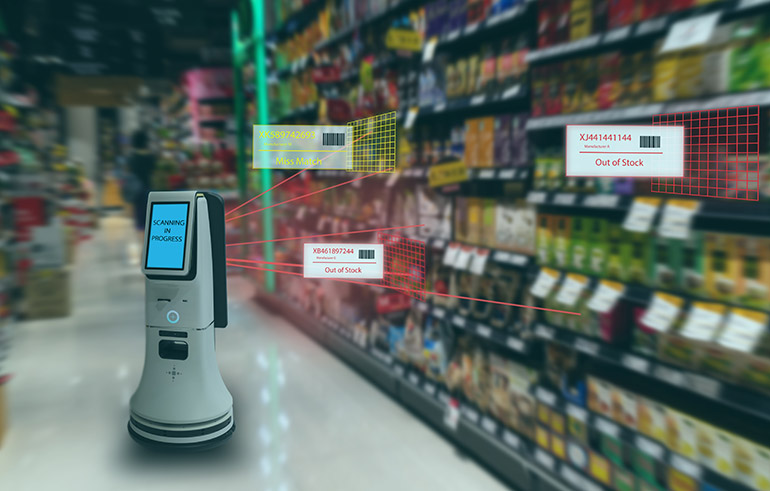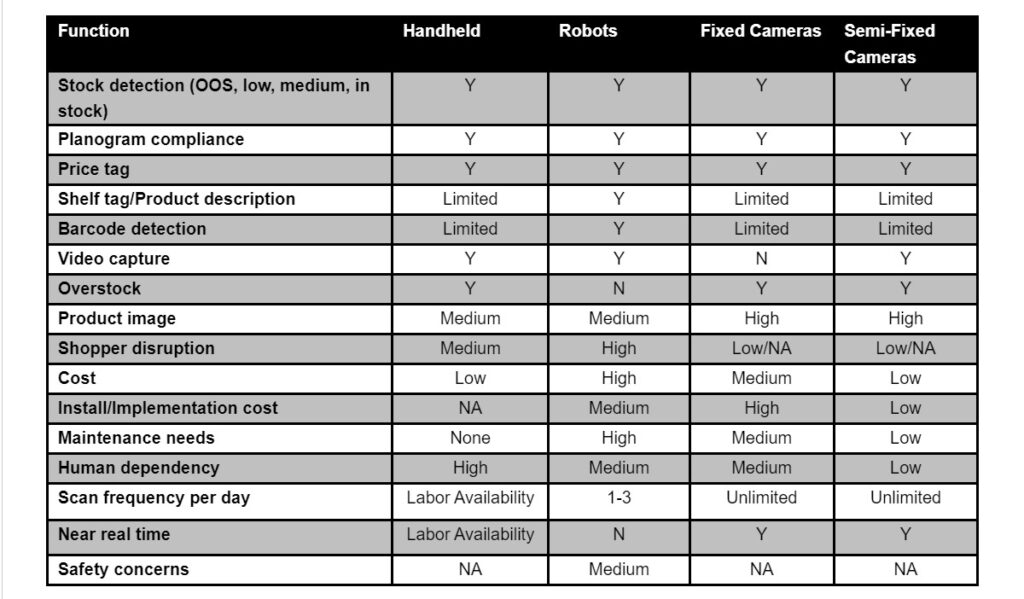|
Listen to this article  |

Retail robots are gradually getting better at tasks such as taking inventory. Source: Adobe Stock
The journey of robotics to establishing a presence in retail stores is a decade in the making. Progress has been slowed by people’s perceptions, the COVID-19 pandemic, and the complexity of problems to solve, as well as the fact that the industry has traditionally been slow to adopt new technologies.
A major challenge is showing a viable return on investment (ROI). Retailers can only achieve ROI when the systems can collect data autonomously, accurately, and repeatedly on a large scale.
Although some retailers have exited pilots with a firm “No,” we are starting to see steady growth in regional adoption, with most large retailers still on the sidelines. Robots have a long-term role in this market, but they will take a new form, expand to address more complex use cases, and have clearer ROI.
Some retail robot deployments expand
Only some of the original players’ solutions remain active after a few recent exits.
Simbe Robotics secured a $28 million Series B round of investment from Eclipse in July. This is positive news, given Eclipse’s expertise with expanding robotics capabilities.
Simbe has been growing its presence with regional and independent grocers. I estimate that the South San Francisco-based company has the most banner presence globally.
Its Tally robot is still differentiated in size, form factor, and visual appeal compared with other mobile inventory robots in the market. Its design is less intrusive in crowded retail aisles.
Badger Technologies is expanding on its multipurpose robots supported by its parent, Jabil. Currently deployed in several retailers globally, the Nicholasville, Ky.-based company recently announced that it is replacing its spill-detection robots with new multipurpose robots.
Badger created this new generation of robots for spill detection, shelf data collection, and security. It showed value by first developing a spill-detection system and building its muscle for scaling operations early on. Badger then moved to data insights and security with its robots.
After Bossa Nova’s exit from more than 400 deployments with Walmart, Badger has reportedly deployed the most robots at a single retailer. I also estimate that the company has the most stores with data collection robots globally.
 Submit your nominations for innovation awards in the 2024 RBR50 awards.
Submit your nominations for innovation awards in the 2024 RBR50 awards.
Providers offer RaaS, software for mobile robots
Zippedi has maintained its steady and conservative approach with a low-cost robotics-as-a-service (RaaS) model. Building on its presence in South America, the Burlingame, Calif.-based company is expanding globally. It is currently in pilots with a large U.S. retailer and several in Europe and beyond.
Brain Corp expanded the use of its floor-sweeping machines by adding cameras for data collection. The San Diego, Calif.-based company collects data by performing additional passes after floor sweeping for better image quality.
Brain plans to launch a robot in 2024 that is dedicated to collecting shelf inventory data. In addition, it offers mobile robots to deliver products delivery and pick up trash and recycling from facility aisles.
The BrainOS software drives robots that can also perform mobile promotions while navigating store aisles. It’s too early to tell about the ROI provided by this new robot.
Brain is closely competing for the top store count for robot rollouts, although it’s not clear how many are performing data collection at a granular level.
Almost all remaining players have a global footprint with a store count hovering around 100 stores under various retailer banners for different robot functions. Few have achieved the century mark within an individual banner.
Setbacks delay end-to-end automation
Following Walmart’s cancellation of its deal with Bossa Nova, Zebra Technologies’ early exit from robotic data collection was a setback. With its global presence and product portfolio, including the former Fetch Robotics, the Lincolnshire, Ill.-based company could have brought end-to-end retail robots faster.
Unfortunately, I think the company could not build a system at the time that met retailers’ requirements for accuracy, repeatability, or ROI. Or, it could have been a calculated move to hold and re-enter via an acquisition. Or, Zebra could bank on its investment in Focal Systems as the long-term solution with fixed cameras.
Stores can use fixed cameras — or not so fixed
In its current form, the robotic solution to data capture was understood by many to be transitional. Eventually, fixed cameras could scale and relieve the robots of their duties in smart stores.
Focal Systems is one fixed-camera provider leading the way and is starting to show signs of scale capabilities. With its multi-year effort across Walmart Canada, I look forward to learning more about whether it is successful for near-real-time shelf data.
A new hybrid solution from Spacee includes a movable fixed camera on a track inside a tube. It combines the benefits of robots and fixed cameras and could provide a viable alternative.
One camera on a track is able to cover a whole side of an aisle. This minimizes the challenge of having robots navigate a store and overcomes obstacles encountered by fixed cameras or handheld devices. It builds on the strength of robots and fixed cameras while eliminating their drawbacks.
Handheld capture is still an option
The number of providers offering handheld image-capture applications for smartphones and tablets is increasing. This has resulted in a crowded market with erratic messaging about capabilities.
Clobotics, Infilect, Pensa Systems, Retech Labs, and Snap2Insight are among the vendors in this space.
Companies like Google and Microsoft have made advances in computer vision and services. Along with the upgraded camera hardware available on mobile devices and the inclusion of lidar capabilities, it has become easier to digitize the store. These technologies make it easier to gain store insights rapidly.
A few systems are starting to differentiate themselves, expand store count, and gain market share and recognition in the industry. The secret sauce in efficiently collecting insights is the feedback given during the image-capture process that minimizes human error and increases image quality.
Develop the best robots for retail
What is the go-to solution? There is still room for consolidation through partnerships and acquisitions. This is especially true for the handheld approach; the field is too crowded as is.
Delivering a robot that’s ready for commercial use takes time and effort. If startups do not manage their runway efficiently from Day 1, they cannot go the distance without significant backing.
The best retail robots will depend on size, store environment, store count, and high-priority problems to solve. Each of the inventory system types below excels in different areas. A detailed and complete review is a must to determine the best solution for high-priority tasks in a particular environment.

The best retail robotics solution will depend on the use case. Click here to enlarge. Source: Georges Mirza
Retail robots to get a second act
The window for robots in their current configurations is narrowing in retail. Despite a decade of development, retailers have yet to achieve the desired scale.
The next phase and next versions of data-collection robots should have greater longevity. This will occur when robots grow arms to pick products off shelves to fulfill orders and to restock shelves. This is an even bigger ask.
I have seen several advancements in this direction. For instance, Vici Robotics has focused on delivering a shelf-stocking system. Equipped with a robotic arm on a platform loaded with products, it can navigate store aisles after hours and diligently replenish shelves.
It’s a difficult use case, so I do not expect overnight success, but ultimately, it is the most desirable outcome.
Adoption to spread from a whole store across stores
The use of robots and computer vision in whole stores and all stores in a chain continues to be elusive, but it is inevitable. Once we start seeing the benefits of chain-wide rollouts, it will drive faster adoption, whether for robots, cameras, or a combination.
The good news is that we’ve seen progress, and some of these approaches will slowly become the standard.
The future is awaiting near-real-time shelf data at scale. After years of waiting, retailers can anticipate the ability of robots to collect, analyze, and act on this data. Such space insights are critical to delivering autonomous, end-to-end category management.
Smart category management will make half of today’s systems and processes redundant, and the other half will open the door for many new solutions. This disruption could take years, and its effects will last even longer. Retail robots’ future is in the making — are you ready?
![Georges Mirza]() About the author
About the author
Georges Mirza has looked ahead at trends in developing transformative systems for the retail and consumer packaged goods (CPG) markets. He established a roadmap for robotic indoor data collection, image recognition, and analytics for retail to address out-of-stocks, inventory levels, and compliance.
Having previously managed portfolios of space and category management solutions at Nielsen, Blue Yonder, and SymphonyAI Retail CPG, Mirza advises companies on strategizing and prioritizing their roadmaps for growth. Follow him on LinkedIn or Twitter.
Credit: Source link


 About the author
About the author
Comments are closed.